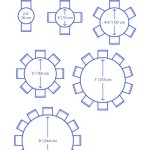Determining Optimal Distance Between a Chandelier and a Table
The placement of a chandelier above a table is a critical element in interior design, impacting both the aesthetic appeal and the functional usability of a space. The distance between the chandelier and the table surface directly influences the lighting quality, visual balance, and overall ambiance of the room. Improper placement can result in glare, insufficient illumination, or a disproportionate appearance, detracting from the intended design. Therefore, carefully considering and calculating the optimal distance is essential for achieving a harmonious and well-lit environment.
Numerous factors contribute to determining the ideal distance. These factors include the size and style of the chandelier, the dimensions of the table, the ceiling height, and the intended purpose of the space. Furthermore, individual preferences and desired aesthetic effects play a role in the final decision. While general guidelines exist, a thorough understanding of these factors allows for a more informed and customized approach to chandelier placement.
Size and Style Considerations
The size and style of the chandelier are primary determinants in establishing the appropriate distance from the table. A large, ornate chandelier requires a greater distance than a smaller, simpler design. This is due to the visual weight and potential for obstruction that a larger fixture presents. Installing a sizable chandelier too close to the table can create a feeling of confinement and overwhelm the space. Conversely, a small chandelier positioned too high may appear insignificant and fail to provide adequate illumination.
The style of the chandelier also influences the recommended distance. Chandeliers with downward-facing lights or intricate details require careful consideration to avoid glare or casting unwanted shadows on the table surface. Upward-facing lights generally allow for a closer placement, as they distribute light more evenly throughout the room. Similarly, chandeliers with shades or diffusers can be positioned closer to the table without causing excessive glare.
To determine the appropriate size of a chandelier for a particular table, a common rule of thumb is to add the length and width of the table in inches and convert that number to inches. This resulting number is generally considered the ideal diameter of the chandelier. For example, a table that is 48 inches wide and 72 inches long would require a chandelier with a diameter of approximately 120 inches (48 + 72 = 120). This guideline ensures that the chandelier is proportionally sized to the table and does not appear too large or too small.
Table Dimensions and Ceiling Height
The dimensions of the table and the ceiling height are equally important considerations when determining the optimal distance. Larger tables require chandeliers to be positioned higher to provide adequate illumination across the entire surface. Conversely, smaller tables may allow for a lower placement of the chandelier, creating a more intimate and focused lighting effect.
Ceiling height is a critical factor that directly impacts the available vertical space. In rooms with low ceilings, it is essential to prioritize headroom and ensure that the chandelier does not obstruct the view or pose a safety hazard. A general guideline is to maintain a minimum of 30 inches between the bottom of the chandelier and the table surface. However, this distance may need to be increased in rooms with taller ceilings to maintain visual balance and prevent the chandelier from appearing too high.
For standard 8-foot ceilings, the bottom of the chandelier should typically hang between 30 and 36 inches above the table. In rooms with 9-foot ceilings, the chandelier can be lowered to hang between 32 and 38 inches above the table. For ceilings taller than 10 feet, the chandelier height can be adjusted accordingly, maintaining a proportional relationship between the table, chandelier, and ceiling height. It's essential to consider the overall proportions of the room to ensure that the chandelier placement complements the existing architectural features.
Functionality and Personal Preference
The intended function of the space and individual preferences also play a significant role in determining the optimal distance. In dining rooms, the chandelier should provide adequate illumination for dining and social gatherings. The placement should avoid casting harsh shadows or creating excessive glare, ensuring a comfortable and inviting atmosphere.
In kitchen spaces where the chandelier is positioned above an island or breakfast bar, the distance may need to be adjusted to accommodate task lighting requirements. The chandelier should provide sufficient light for food preparation and other activities performed in the area. Consider using dimmable fixtures to allow for adjustable lighting levels based on the specific task or mood.
Personal preferences also influence the final decision. Some individuals prefer a more dramatic and eye-catching effect, opting for a lower placement of the chandelier to create a focal point. Others may prioritize a more subtle and understated look, choosing a higher placement to blend the chandelier seamlessly into the overall design. It is crucial to experiment with different heights and lighting levels to determine the most aesthetically pleasing and functional arrangement for the specific space.
The style of the room and existing decor should also be considered. A modern, minimalist space may benefit from a sleek, streamlined chandelier positioned at a slightly higher distance to maintain a clean and uncluttered aesthetic. A more traditional or ornate space may call for a lower placement of the chandelier to enhance the overall sense of grandeur and elegance.
Ultimately, determining the ideal distance between a chandelier and a table is a balancing act between aesthetic considerations, functional requirements, and personal preferences. By carefully considering the factors outlined above, it is possible to achieve a harmonious and well-lit space that enhances the overall design and functionality of the room. Experimentation and adjustment are often necessary to fine-tune the placement and ensure that the chandelier effectively serves its intended purpose while complementing the surrounding environment.
In cases where multiple light fixtures are used above a larger table, the distances between the fixtures, and between the fixtures and the table, need to be carefully considered. Spacing the fixtures evenly will provide uniform illumination. The height of each fixture should also be consistent to maintain visual harmony, unless the design specifically calls for staggered heights for a more artistic effect.
The type of light bulbs used in the chandelier also impacts the perceived brightness and glare. LED bulbs are often preferred for their energy efficiency and long lifespan. However, the color temperature and light output should be carefully selected to create the desired ambiance. Warm white bulbs (2700K-3000K) are generally recommended for dining areas, as they create a cozy and inviting atmosphere. Cooler white bulbs (3500K-4000K) may be more appropriate for task lighting in kitchens or home offices.
Regular maintenance, such as dusting and cleaning, is critical to ensure that the chandelier continues to provide optimal illumination. Dust buildup can significantly reduce the brightness and clarity of the light. Cleaning the chandelier regularly will also prolong its lifespan and maintain its aesthetic appeal.
Professional installation is recommended, especially for larger or more complex chandeliers. A qualified electrician can ensure that the chandelier is properly wired and securely mounted, minimizing the risk of electrical hazards or structural damage. Professional installation also provides peace of mind, knowing that the chandelier has been installed correctly and safely.

Dining Room Chandelier Size Guide Delmarfans Com

How To Guide For Hanging Lights Liven Design

Distance From Dining Room Table To Bottom Of Chandelier Eq3 Discounts

Dining Room Lighting Ideas

Dining Room Lighting Ideas

The Ultimate Guide To Pendant Lighting For A Cozy Home Delmarfans Com

The How To Lighting Guide Lightology

How To Choose The Perfect Dining Room Light Fixture Graham S Living

The Ultimate Guide To Pendant Lighting For A Cozy Home Delmarfans Com

The How To Lighting Guide Lightology








